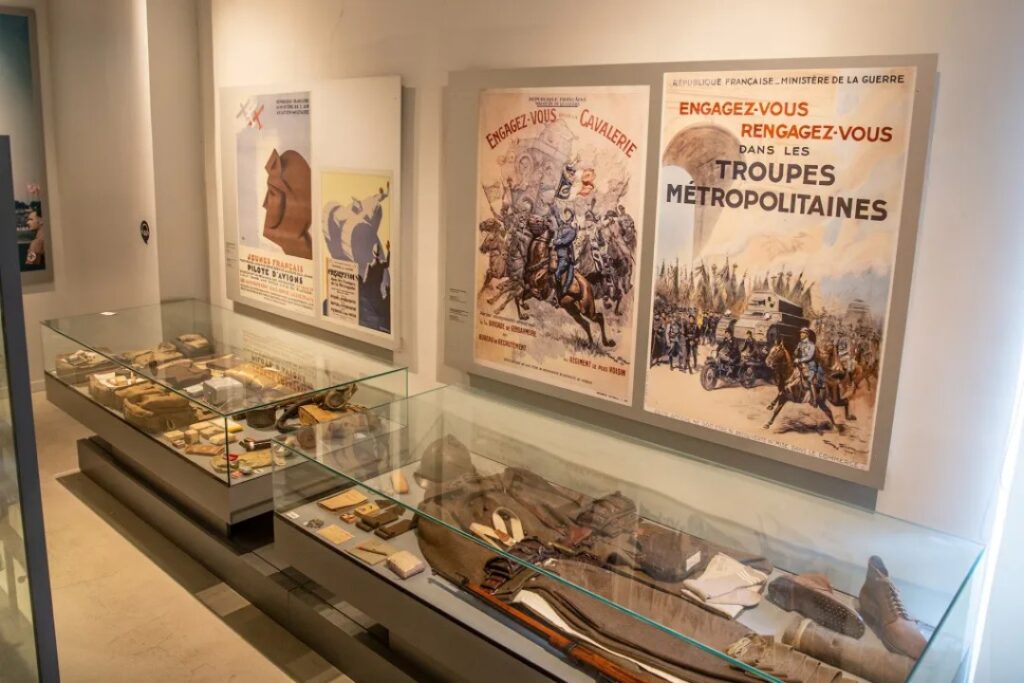The history of humanity is basically the history of wars and conflicts. Conflicts that inevitably affect everyone involved. However, war can also be the strong factor for uniting people and be the catalyst for invention and technological development. Nowadays military—and patriotic in some respects—museums become very attractive point of interest for many people, and of course tourists too. Here we have compiled a list of ten museums exhibiting weaponry, military equipment, portraying war history, the sacrifices and the feats of soldiers.
1. Imperial War Museums (The United Kingdom)
The Imperial Military Museum had been building its collections since the spring of 1917, long before World War I ended (November 1918), and opened its doors in 1920. Its exhibitions work in order to keep the memory of wars and conflicts that involved the United Kingdom and the British Empire in the 20th and 21st centuries. Expositions cover the period from World War I to the present day and present a vast collection of weapons and military equipment engaged in military affairs, as well as artwork, films, documentaries, photographs, printed materials, and sound recordings—there are 33,000 of them in museum’s archive. Some exhibitions include themed installations that help visitors catch the spirit of the era they tell about.
Aside from the main museum in London, there are other branches. The Imperial War Museum Duxford is dedicated to aviation. HMS Belfast, the light cruiser of the Royal Navy turned into museum ship (London, River Thames) and the Churchill War Rooms, an underground complex in London, are also definitely worth visiting. Then there’s a northern branch, Imperial War Museum North in Manchester, which received its first visitors in 2002.
2. Army Museum (Paris, France)
The Paris Army Museum is located in the very heart of Paris, at “Les Invalides” (The House of invalids), a complex built by Louis XIV for soldiers injured in wars, one mile away from the Eiffel Tower. The museum as we know it today was created in 1905 by merger of the Museum of Artillery and the Historical Army Museum. The basis of the exhibition is a huge collection of military equipment and weaponry used since ancient times to the present day from all over the world. Of course artillery is represented best, but visitors can also explore huge collection of knight’s armor and medieval cold steel, including famous swords once owned by European monarchs, army uniforms of different eras and other military equipment. There are very rich exhibitions dedicated to the World Wars I and II. Some of them also include animated 3D mock-ups, depicting the course of important and famous battles with video projections.

3. Army museum Žižkov (Prague, Czech Republic)
The Czech Republic has rich and vivid military history. That there is at least the Hussite Wars and Jan Žižka, prominent warrior and commander of that time. The city of Žižkov (eventually it became a district of Prague) was named after him. The museum’s collection includes weapons and military life artifacts of a great period of time, from the Middle Ages to the present day. The museum has rich exhibitions dedicated to the World War I, interwar period and of course World War II. Traditional exhibits here are often combined with large dioramas. Visitors usually get attracted by the natural-size WW I trench complex model from the First World War—one can easily walk there exploring dioramas that portray everyday soldiers’ life. Exhibitions in the museum are often augmented with projected videos, recreating historical events, adding historical context and enhancing visitor’s experience.

4. Diorama museum (Voronezh, Russian Federation)
The Voronezh Diorama museum is located in a park zone in the center of the city, combined with the memorial complex with a common grave and eternal flame for the warriors who defended the city. In the open air there is an exhibition of World War II cannons, self-propelled artillery and other weapons of that period. Indoors there are exhibitions representing military awards and insignia of Russian Empire, USSR and modern Russia, along with the collection of militatry uniform of these periods. Main exhibition is all about the WW II (Great Patriotic war as Russians say) period. It presents ammunition, equipment, wartime items, letters, photos and handmade art, war trophies etc.

Huge multimedia diorama is the main point of interest for visitors here. Its design involves several powerful projectors that display some WWII-related content, telling about the Great Patriotic war events. In the middle of the main hall there is a 3D mock-up of Voronezh city, divided into two parts by the virtual river made of projected light. Advanced technology makes it possible for visitors to see the severe consequences of war, that demolished the city almost completely.
All of these multimedia installations, both technological and creative parts, were crafted by Russian multimedia systems integrator “IT GROUP OPEN” during recent major repairs session.
5. Museum of Military History (Vienna, Austria)
This one is the oldest museum on our list. Museum of Military History was founded in the middle of 19th century. Its first building construction was completed in 1856 and that was one of the first construction projects of young young Kaiser Franz Joseph I. The building was originally built as a museum (the oldest one in Austria nowadays). The museum is located in Vienna Arsenal complex and features an eclectic architecture with Byzantine and Gothic style motifs.

Exhibitions of the Vienna museum tell visitors of rich military history of Austria. Here you can explore weapons, armors, tanks, airplanes, uniforms, flags, medals, war ship models, documents and many more military affairs-connected items. An important part of the exhibition is the car in which Archduke Franz Ferdinand, Franz Joseph’s nephew and the Austro-Hungarian Empire throne heir died, assassinated by Gavrilo Princip. This incident eventually sparkled World War I. The museum also exhibits the uniform Franz Ferdinand was wearing at the time of the incident.
6. National Museum of Military History, (Sofia, Bulgaria)
The National Museum of Military History was founded in 1916, and today its huge collection numbers more than one million exhibits related to military affairs that have been numerous in the history of Bulgaria. Museum’s size is quite impressive: its open area is more than 430 000 square feet large. Here visitors can explore heavy military equipment: aircraft, missiles, tanks, military combat, transportation and engineering vehicles. The museum exhibits an impressive collection of artillery, including cannons, multiple launch rocket systems, self-propelled guns and more.

The covered part of the museum, placed in a large building, is about 54,000 square feet large. Here visitors can explore weapons and military equipment from different eras, ranging from antiquity to modern day, through Middle Ages, Ottoman occupation period, Russian-Turkish wars, and, of course, both World Wars. Some exhibitions feature thematic dioramas complemented by videos projected to large screens. The museum also exhibits a large collection of medals and insignia, numbering up to 960 pieces.
7. Royal Thai Air Force Museum (Bangkok, Thailand)
The Royal Thai Air Force Museum was founded in 1952 by order of Rama IX, the King of Thailand. Today the museum exhibits more than 60 aircraft, and there are quite rare planes among them. For example, the Japanese World War II Tachikawa Ki-36 trainer, one of the two left in the world, and the only surviving Vought O2U Corsair biplane. An interesting fact: initially this facility primarily served as a platform for collecting samples of the Thai air fleet, repairing them and returning the planes to service. It wasn’t until the 1970s that the expositional purpose became dominant here.
The museum is divided into 5 thematic zones, each one dedicated to a specific period or aircraft type. Not only airplanes are presented here, large part of exhibition focuses on helicopters. Exploring the airplanes and helicopters exhibited here visitors can track down the entire (almost) history of aviation, starting with some of the earliest airplanes built before World War I. Some of these were produced here, in Thailand (Siam), thanks to Rama VI Vajiravudh, who was an avid aviation enthusiast and flew one of these planes. Old Nieuport II.N, the very plane he flew, is also exhibited here. Airplanes from the World War II and Cold War eras are represented pretty well, some (almost) modern fighters from the late 20th century are exhibited too.

Aside from airplanes and helicopters here visitors can explore Thai Air Force weaponry, uniforms, flight simulators and other aviation-related items.
8. China Aviation Museum (Datangshan, Beijing, China)
Let’s continue with aviation. The China Aviation Museum is located at the foothills of the Datangshan mountain, 31 miles from Beijing. It was opened in November 1989 to celebrate the 40th anniversary of People’s Liberation Army Air Force. The exposition is located both outdoors and indoors, inside huge hangars; part of it occupies underground tunnels and bunkers once belonged to the military air base. The museum is the largest in China, presenting more than 300 airplanes, more than 200 helicopter types and more than 13,000 samples of anti-aircraft weaponry and radar equipment, etc.
There are many quite interesting exhibits at the museum. For instance, visitors can explore Mao Zedong’s personal transport aircraft, De Havilland Mosquito, one of the fastest piston-engine planes of the World War II (only a few piston-engined aircraft could exceed 435 mph or 700 km/h airspeed). You could also find here USSR TU-124 passenger liners, English Hawker Siddeley Trident, American Douglas DC-8, legendary Soviet IL-2 attack aircraft. Large part of the exhibition consists of aircraft of the Cold War era, including many MiG fighters, like MIG-9, MIG-17 and MIG-23, plus Chinese-made aircraft, transport airplanes. One can discover even the sample of Lockheed D-21 reconnaissance drone, capable of reaching Mach 3.3+ speed and Lockheed F-104 Starfighter—supersonic interceptor that somehow ended up in this collection.
9. Cambodian Landmine Museum (Cambodia, Angkor National Park, 15,5 miles north of Siem Reap)
In the 20th century, military conflicts in Cambodia persisted for decades, leaving terrible marks on the country and the people involved. Still the country remains one of the most heavily mined in the world. Every year dozens of civilians are wounded by landmines. The Landmine Museum, which also serves as a relief facility for orphaned children, will hardly impress you with its size or with diversity of its collections. Though it is definitely worth visiting in order to understand the dire consequences of long-lasting wars.

The museum was founded by Aki Ra, who joined the Khmer Rouge in his youth. For many years, he worked hard trying to make his country a safer place by clearing it of landmines. Eventually he gathered an impressive collection of mines, housed in four galleries today. Of course all of the mines are defused and harmless to visitors now.
10. German Maritime Museum (Bremerhaven, Germany)
Bremerhaven is a German city placed 43 miles from Bremen at the mouth of the Weser River, and its location makes it a good place for maritime exhibitions. The Maritime Museum opened its doors in 1975. Its exhibitions tell about the crucially important role seafaring has played in human history. Here visitors can explore prehistoric ships, the Roman Empire ships, the Middle Ages and the Renaissance vessels and of course the modern-day ones. One of the most notable exhibits is the Bremen Cog, a medieval ship built around 1380.

But the most important and unique showpiece in the museum is the German World War II submarine, U2540 “Wilhelm Bauer”, an example of the XXI series of submarines. Her unique feature is the ability to recharge its batteries while still submerged, without surfacing. For good, she never fired a combat torpedo successfully.







